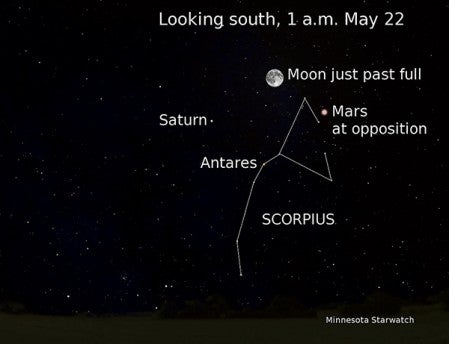Star Watch: Opposites attract
Published 5:17 pm Sunday, May 1, 2016

By Deane Morrison
University of Minnesota
On the 9th of May we’re treated to the spectacle of a small black dot crawling across the sun’s face. This is a rare transit of Mercury, when the little planet zips between Earth and the sun.
The show runs from 6:13 a.m. to 1:42 p.m. CDT A small telescope will reveal the planet’s journey, but viewers must take the same precautions as with an eclipse to protect both telescopes and eyes. Mercury’s transit comes on the heels of its April visit to the evening sky, when it had just emerged from behind the sun.
Not to be outdone, Mars reaches the climax of its 2016 appearance in the early morning of the 22nd, when Earth laps the red planet in the orbital race and it shines opposite the sun in the sky. At opposition, as it is called, Mars will be a mere 47.4 million miles away, blazing like a fiery ruby just beyond the claws of Scorpius. It rises at sunset and stays up all night, moving from southeast to southwest and reaching its highest point in the sky around 1 a.m.
Close as it comes at opposition, Mars passes approximately 600,000 miles closer on the 30th. This happens because lapping a planet isn’t the same as one runner lapping another. The orbits of Mars and Earth aren’t perfect circles, nor are they on quite the same plane. Consequently, opposition and closest approach don’t coincide; the interval between them ranges from a mere 10 minutes to as much as 8.5 days. Mars’s next opposition will be in July 2018.
Just below Mars is Antares, the gigantic red star at the scorpion’s heart. Its name means “rival of Mars,” but this month it’s clearly outclassed. Also traveling with Scorpius is Saturn, a bright light east of Mars. Saturn is coming up on its own opposition the first week in June, and if you have a small telescope, its rings are now very favorably tilted.
If you’re outside after Mars is well up in the east but before about 1:30 a.m., you’ll see Jupiter outshining everything else in the west and you can compare the bright red planet to the perennially brilliant golden one.
One cautionary note: May’s full moon shines the night of the 21st-22nd, right above Mars and Saturn. You may want to view the planets 90 minutes before dawn a few days prior, or in the evening a few days afterward.
The University of Minnesota offers public viewings of the night sky at its Duluth and Twin Cities campuses. For more information and viewing schedules, see:
Duluth, Marshall W. Alworth Planetarium: www.d.umn.edu/planet
Twin Cities, Minnesota Institute for Astrophysics (during fall and spring semesters): www.astro.umn.edu/outreach/pubnight.
Check out the astronomy programs at the University of Minnesota’s Bell Museum ExploraDome: www.bellmuseum.umn.edu/ForGroups/ExploraDome/index.htm.
Contact: Deane Morrison, University Relations, (612) 624-2346,morri029@umn.edu
Find U of M astronomers and links to the world of astronomy athttp://www.astro.umn.edu.

